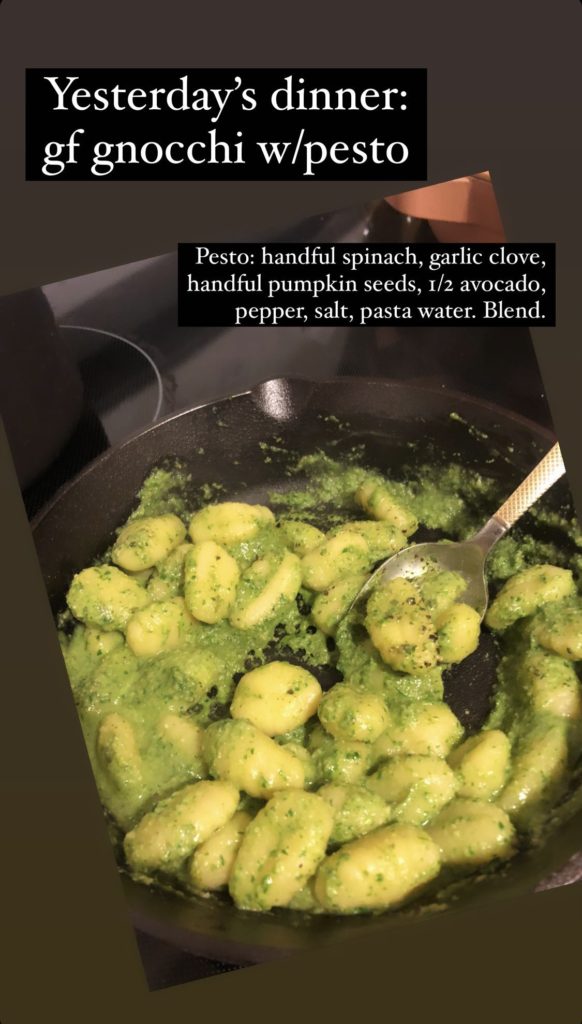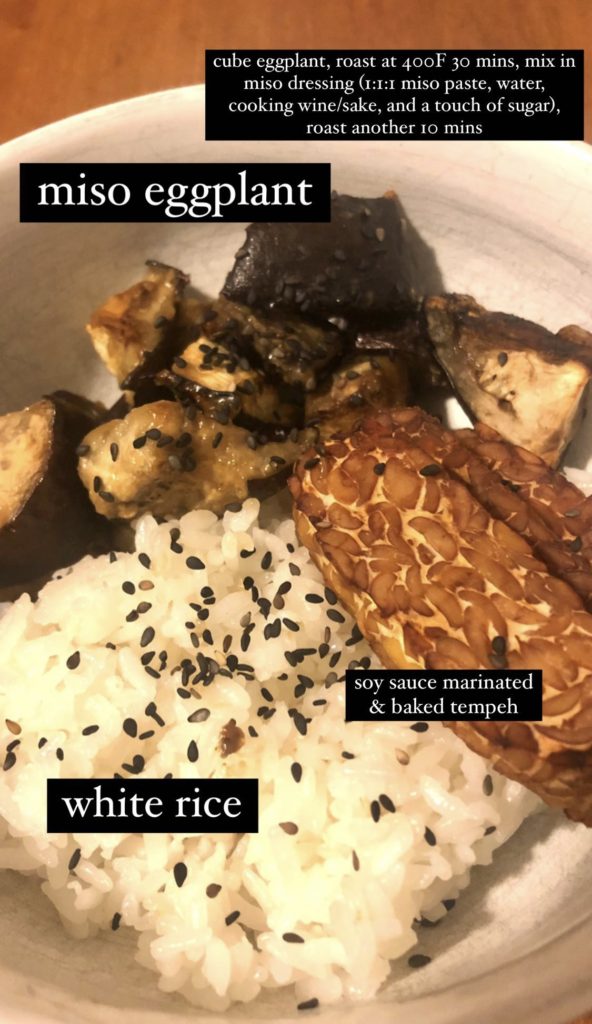This year, I started off college a little differently. Not only were all my classes finally in person (gasp!), but I also had an apartment that comes with an open kitchen, which has become my dominion.

There’s no way around it: food is fuel. It’s also no secret that research has consistently found that eating a nutritious, varied diet can improve concentration, enhance memory, prolong attention span, and improve thinking. Students who regularly eat nutrient-rich foods also display more efficient problem-solving skills, greater fact comprehension, and stronger mental recall. That’s why it’s so important to me to have the ability to exercise control on the ingredients I’m cooking with and their delicious mode of preparation.
These are my staple, shelf-friendly ingredients I always have on hand:
- apple cider vinegar
- mild olive oil, for roasting and basic cooking
- cold pressed organic extra virgin olive oil, for drizzling
- runny honey
- tamari
- rice
- canned organic chickpeas
- japanese sweet potatoes
- tomato paste
- miso paste
- harissa paste
- spices
Each week, I get a delivery from Misfits, a delivery service that provides fresh, mostly organic produce to my doorstep. I can choose which ingredients I’m in the mood for – once I even got funky ingredients like ramps. Extra bonus is that their cardboard boxes are 100% recyclable and made of recycled materials.
Onto the my three go-to dishes!
POWER PESTO PROTAGONIST
Pasta is always an easy dish to fall back on. But the quickest pasta of them all has to be gnocchi. Whether you do potato or cauliflower is up to you, but my favorite is a gluten-free potato gnocchi from Simply Wise (which can be found at Marshall’s). For an extra protein boost, you can also use chickpea pasta.
- 1 cup Spinach. Spinach may decrease oxidative stress, improve eye health. Spinach is rich in many nutrients, including Vitamin A, Vitamin C, Vitamin K, iron, folate, and potassium.
- 1-2 handfuls Pumpkin seeds. These seeds are high in antioxidants, fiber, and magnesium. Antioxidants help reduce inflammation, fiber helps you stay fuller longer (yay!), and magnesium helps control blood pressure and form/maintain healthy bones. They’re also rather high in protein with 10 grams per 1/4 cup.
- 1/2 avocado. Avocados contain high levels of healthy, beneficial fats, which can help a person feel fuller between meals.
- Garlic. Garlic is rich in antioxidant compounds such as polyphenols and flavonoids, which support the body’s protective mechanisms against oxidative damage.
- Pasta water. I always say pasta water is gold – repurpose it whenever you can! The starch from the pastta water adds cohesion to any sauce.
- Optional: parsley. This herb is rich in many vitamins, particularly vitamin K, which is needed for blood clotting and bone health. Parsley is also a great source of vitamins A and C — important nutrients with antioxidant properties.
- Optional: lemon juice.
- Salt.
- Black pepper.
Blend all your sauce ingredients. If you’re feeling fancy, add it into a pan with your gnocchi until i reaches your creamy desires.
MISO HAPPY EGGPLANT
When misfits gave me an eggplant, one of my favorite food memories came to mind: eating Nobu’s jammy miso eggplant. While their recipe requires a little too much TLC for my time and patience, I short-cutted it to get a deliciously jammy miso eggplant.
- Eggplant. Eggplant has antioxidants like vitamins A and C, which help protect your cells against damage. I would say it’s best feature is that it can really embrace any sauce you add to it.
- Tempeh. Tempeh is a fermented soy product that’s a popular vegetarian meat replacement. Per serving, it has 15 grams of protein. Tempeh is also a good dairy-free source of calcium. One cup (166 grams) of tempeh contains about 2/3 of the calcium found in 1 cup of whole milk.
- Miso paste. It is loaded with other nutrients along with its beneficial bacteria and enzymes. The fermentation process involved in the production of miso promotes levels of beneficial bacteria. Miso provides protein, vitamin B12, vitamin B2, vitamin E, vitamin K, choline, linoleic acid, lecithin, and dietary fiber.
- Cooking wine.
- Touch of sugar, honey, or maple syrup.
- Rice. A staple. While I used white rice, if you’re really looking to maximize the power of this dish, give a try with black rice. Research shows that black rice has the highest antioxidant activity of all the varieties, making it a nutritious choice. I couldn’t find any in my local supermarket so white rice did the job.
I call this the miso happy bowl because it’s just so easy to put together. Here’s how it goes: Preheat oven to 400F. Cube your eggplant, add olive oil and salt, and set the timer for 30 minutes. Slice your tempeh and add soy sauce and lay the slices on a separate pan in the oven. in the meantime, put your rice to cook in a rice cooker. Then, mix 2 tbsp miso paste, 2 tbsp cooking wine or mirin, 1 tbsp water, a tiny spoon of sugar or maple syrup. Once the timer for 30 minutes rings, add in your miso mixture and evenly coat all the eggplant cubes. Throw it in the oven for another 10 minutes. By that point, it’s time to fluff up your rice, plate it, alongside your miso eggplant cubes and soy-saucy tempeh. Top with sesame seeds or scallions if you have them on hand!
THE UMAMI BOMB
I call this dish the “umami bomb” and for good reason.
- Leafy greens. While you can use any leafy green here, I really like Tuscan Kale. In this smoothie, the kale flavor is undetectable apart from the green hue. Nonetheless, kale is considered to be one of the most nutrient dense foods out there. A single cup of raw kale has 206% of the DV (daily value) of vitamin A, 684% of the DV of vitamin K, 134% of the DV of vitamin C, and the list goes on and on. Fun fact: a cup of raw kale contains even more vitamin C than a whole orange.
- Mushrooms. Mushrooms are a rich, low calorie source of fiber, protein, and antioxidants. They may also mitigate the risk of developing serious health conditions, such as Alzheimer’s, heart disease, cancer, and diabetes. I’m partial to the shiitake variety, Shiitake mushrooms contain eritadenine, a compound known to reduce cholesterol levels in the blood. They also contain beta-glucans that reduce inflammation and help prevent the intestines from absorbing cholesterol.
- Canned beans. Make sure to purchase canned beans in a bpa-free container – research links Bisphenol A to some major health concerns, such as a higher risk of certain cancers, reduced fertility, diabetes, and birth defects. Use navy beans, black beans, chickpeas – totally up to you.
- Garlic. Garlic is rich in antioxidant compounds such as polyphenols and flavonoids, which support the body’s protective mechanisms against oxidative damage.
- Smoked paprika. smoked paprika has intense, woodsy smoke flavors underscored by a hint of fruitiness from the peppers
- Red pepper and black pepper.
- Tamari. This is the gluten-free version of soy sauce, but you can equally use soy sauce here.
Essentially, you sauté the mushrooms for about 4 minutes, then add in the soy sauce, smoked paprika, and salt, and continue to cook for about 10 more minutes. Put them aside, and oil your pan again, adding in the garlic and red and black peppers. Once fragrant, add in the leafy greens and stir until they have color. Feel free to add splashes of water to help them cook. Add back in your mushrooms and beans. Serve.
I like to have this dish either on top of a bed of quinoa or wild rice, or alongside my trusty japanese sweet potato. They are also a great source of vitamins (especially vitamin A), minerals, potassium, iron, and copper. high in antioxidants and healthier than a white potato.
I hope you’ve enjoyed this little bit on my go-to meals to keep me powered throughout the semester. And for all the student’s out there, good luck on finals. You know more than you think you do!

